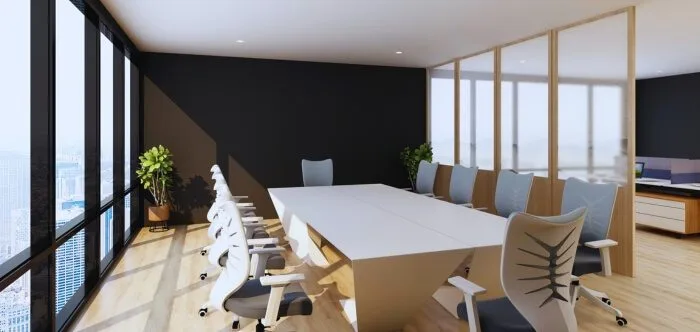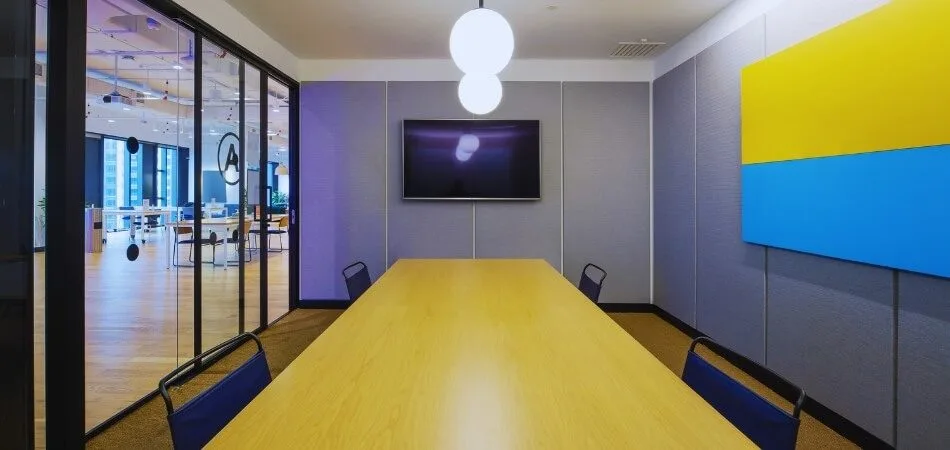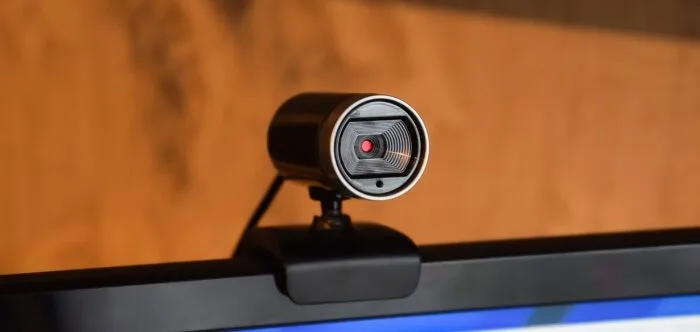Webcams have become essential tools in today’s digital world, especially in professional settings. As we explore the area of remote work and virtual meetings, a common question arises, can you use a webcam for a conference room?
Yes, you can use a webcam for a conference room. To enhance your conference room’s connectivity, it’s crucial to opt for a high-quality webcam equipped with a wide-angle lens, a capable microphone, and HD video functionality. This combination ensures that visuals are clear and audio is crisp, facilitating effective communication with remote participants.
For those who are looking to make their conference rooms more versatile and tech-savvy, understanding the right webcam setup is key. Stay with us to learn more about using webcams in a conference room.
What is the Purpose of the Conference Room?
Conference rooms serve as the hub for collaborative efforts in a business environment. They are designed for group discussions, bringing up a shared space where ideas can merge and evolve. This setting is ideal for brainstorming sessions, team meetings, and decision-making processes.
With the introduction of advanced technology, these rooms have evolved beyond just physical meetings. For instance, using webcam on conference room works as a bridge to minimize the gap between remote and in-person participants. This integration enhances the effectiveness of communication, making it inclusive and dynamic.
Moreover, conference rooms symbolize the professional ethos of an organization. They often host client meetings, presenting a formal and well-equipped space that reflects the company’s standards and commitment to collaboration. This environment is essential for creating a positive and lasting impression on clients and partners.
Can You Use a Webcam for a Conference Room?
Yes, you can use a webcam in a conference room. It’s an efficient way to bring remote participants into the meeting space. Webcams offer a practical solution for seamless communication in a digital world. Here is an explanation of whether you can use a webcam for a conference room.
Webcam Quality
The quality of the webcam significantly influences the meeting experience. High-definition video ensures clear visuals, crucial for effective communication. Opt for webcams with superior resolution to avoid grainy or unclear images. A good quality webcam helps in mimicking the clarity of in-person interactions.
Audio Clarity
Good audio is as important as video quality. Integrated microphones in webcams should offer clear and uninterrupted sound. Noise-cancelling features are a bonus to eliminate background disturbances. This ensures that every participant, whether remote or in the room, can be heard clearly.
Field of View
A wide-angle lens is essential for capturing everyone in the room. It ensures that no one is left out of the frame during discussions. Webcams with a broader field of view are preferable for large rooms. This feature is particularly useful for dynamic meetings with multiple speakers.
Compatibility and Connectivity
Ensure the webcam is compatible with your conference room’s tech setup. It should easily integrate with various conferencing platforms and software. Look for webcams that offer simple plug-and-play functionality. Reliable connectivity, whether through USB or wireless, is crucial for uninterrupted meetings.
Types of Webcams Suitable for Conference Rooms
Selecting the right webcam for your conference room can be a game-changer for your business communications. It’s about finding the perfect balance between quality, functionality, and user-friendliness. Here’s a look at various types of webcams that are ideal for different conference room settings.
High-Definition Webcams
A high-definition webcam is among the top technologies for conference rooms offering enough clarity that is crucial for professional meetings. They provide crisp, clear images, making remote communication more effective. These are ideal for presentations where detail is key. HD webcams ensure that every participant, near or far, experiences a sharp visual quality.
Wide-Angle Webcams
Wide-angle webcams capture a broader view, perfect for large conference rooms. They ensure that all attendees are visible, even in spacious settings. This type is essential for group discussions, as it captures every gesture and expression. Wide-angle lenses help in creating an inclusive meeting environment for all participants.
PTZ (Pan-Tilt-Zoom) Webcams
PTZ webcams offer flexibility in adjusting the field of view. They can pan across the room, tilt to different angles, and zoom in for details. These are particularly useful for dynamic meetings with active participation. PTZ cameras are great for capturing the nuances of in-person interactions.
USB Plug-and-Play Webcams
USB webcams provide easy connectivity and setup, ideal for quick meetings. They are compatible with most laptops and PCs, offering a hassle-free solution. These webcams are a good choice for smaller, unprepared gatherings. Their simplicity and ease of use make them a popular choice.
Wireless Webcams
Wireless webcams offer the convenience of placement without the clutter of cables. They are perfect for modern, minimalist conference rooms. These webcams can be positioned optimally without worrying about wire length. Wireless models add to the aesthetic and functional appeal of a conference space.
Webcams with Built-in Microphones
Webcams that come with integrated microphones simplify the audio setup. They capture clear sound along with good video quality. These are ideal for smaller rooms where additional audio equipment is not feasible. Built-in microphones in webcams ensure a compact and efficient setup.
The right webcam for your conference room depends on your specific needs, from the room’s size to the nature of your meetings. Understanding these types will help you make an informed decision that enhances your meeting experience.
After knowing “Can you use a webcam for a conference room?”, the next thing that matters the most is setting up the webcam. Get to the following section to know the basic steps for the setup.
Essential Steps to Set Up a Webcam in a Conference Room
Setting up a webcam in a conference room is a straightforward process, but it’s crucial to get it right. Ensuring proper installation and setup will enhance the quality of your video conferences. Follow these essential steps to set up your webcam efficiently and effectively.
Step 1: Selecting the Right Webcam
Choose a webcam that suits the size and requirements of your conference room. Consider factors like video quality, field of view, and microphone capability. High-definition, wide-angle webcams are generally preferred for clearer visuals and broader coverage.
Step 2: Optimal Positioning of the Webcam
Position the webcam at eye level to simulate a natural face-to-face interaction. It should capture the entire conference table and all participants. Avoid placing it too high or low, as this can lead to unflattering angles.
Step 3: Ensuring Adequate Lighting
Good lighting is crucial for clear video quality. Position the webcam so that the light source is in front of the participants, not behind. Avoid harsh lights or direct sunlight, which can cause glare and shadows.
Step 4: Setting Up the Audio
If the webcam has a built-in microphone, test its range and clarity. For larger rooms, consider additional microphones to ensure everyone can be heard. Avoid areas with echo or background noise for the best audio quality.
Step 5: Connecting to the Computer or Network
Connect the webcam to the conference room’s computer or network. Use a USB port for plug-and-play webcams, or configure wireless connections as needed. Ensure the connection is secure and stable for uninterrupted meetings.
Step 6: Installing Necessary Software and Drivers
Install any required drivers or software for the webcam. This might include specific applications for video conferencing or camera control. Keep the software updated to ensure compatibility and access to the latest features.
Step 7: Testing Before Use
Conduct a test run before any important meetings. Check both video and audio quality, and make adjustments as needed. Testing ensures everything works smoothly during actual conferences, avoiding technical hiccups.
Meanwhile, choosing the most appropriate conference room is essential before setting up a webcam. For this, you can book a conference room in Outlook because it allows you to view and manage room bookings more conveniently.
Things to Consider While Setting Up a Webcam in a Conference Room
Installing a webcam in a conference room enhances virtual meeting experiences, but it requires careful consideration. The right setup ensures clarity and efficiency in communication. Here are some key factors to consider for optimal webcam setup in a conference room.
- Camera Quality: High-resolution webcams offer better image quality, crucial for professional interactions. Choose a webcam with at least 1080p resolution for clear visuals.
- Field of View: A wide-angle webcam captures more of the room, making it ideal for group meetings. Ensure the webcam’s field of view encompasses all participants.
- Positioning: Place the webcam at eye level to mimic natural eye contact. It should be centrally located to evenly capture all attendees.
- Lighting: Proper lighting is essential; it should illuminate faces without causing glare or shadows. Avoid backlighting from windows or overly bright overhead lights.
- Audio Capability: If the webcam has an integrated microphone, test its clarity and range. For larger rooms, consider additional external microphones.
- Connectivity: Ensure the webcam is compatible with your system and easy to connect. Check for USB or wireless options for seamless integration.
- Software Requirements: Install the necessary drivers and software for the webcam. Keep them updated for smooth operation and compatibility with conferencing platforms.
The right setup of a webcam in a conference room is not just about the technology but also about its thoughtful integration into the space. Considering these factors will lead to more effective and professional virtual meetings.
Frequently Asked Questions
What is the difference between a webcam and a conference camera?
A webcam is like a personal camera for your computer, while a conference camera is designed for group meetings. Conference cameras have wider lenses, better audio quality, and features like pan-tilt-zoom controls to capture everyone in the room effectively. They’re like the professional cameras you see in news studios.
Are webcams often used for video conferencing?
Yes, webcams are commonly used for video conferencing. While they might not offer the same level of quality as dedicated conference cameras, they’re a convenient and affordable option for many people. Just make sure your webcam is positioned at eye level and in a well-lit area for optimal video quality.
How to position webcam for video conferencing?
Think of your webcam as a friend. Place it at eye level, facing you directly. Make sure there’s enough light on your face, but avoid harsh shadows. A little background blur can help you look more professional.
Is it better to have a webcam with or without light?
A webcam with built-in light can be helpful in low-light conditions. However, for optimal video quality, it’s often better to use external lighting sources like a desk lamp or ring light. This gives you more control over the lighting and can help you achieve a more professional look.
Is webcam a real-time camera?
Yes, webcams are real-time cameras. They capture video and transmit it directly to your computer or device, allowing you to see live footage. It’s like having a tiny window to the world right on your screen.
Conclusion
The integration of webcams into conference rooms has become a necessity. The purpose of this is to enhance the quality and effectiveness of professional communication by providing the best tools to carry it out.
Can you use a webcam for a conference room? is no longer just a question, but a vital consideration for modern businesses. Making the right choice in webcam technology directly impacts the success of virtual meetings and collaborations.
Choosing the appropriate webcam involves more than just technical specifications; it’s about creating an environment useful for productive and engaging interactions. By addressing these key factors, companies can ensure their conference rooms are equipped for the demands of the digital era.








